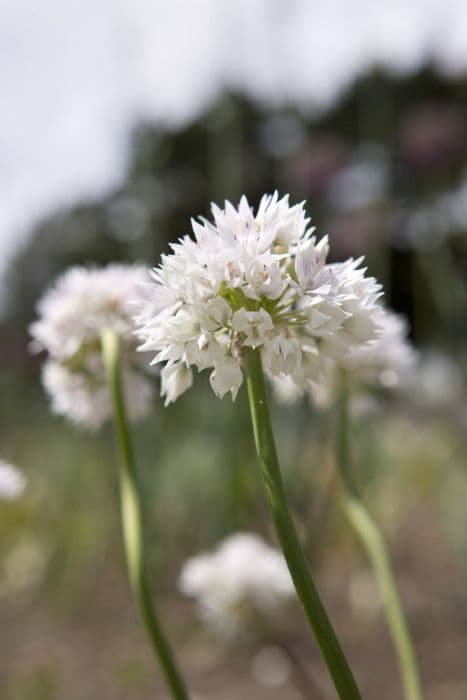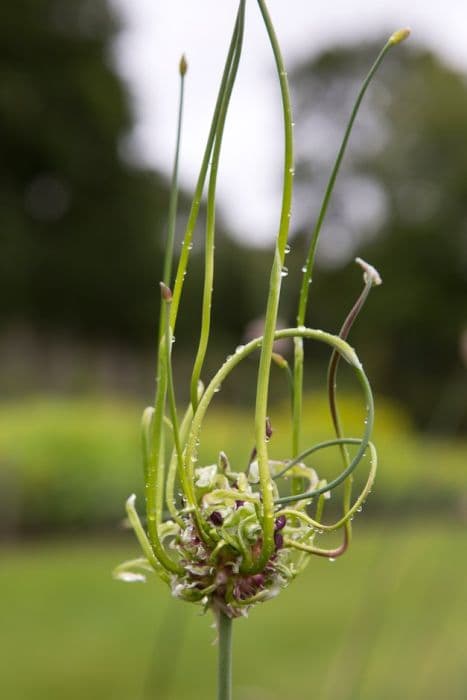Wild Onion Allium macleanii 'His Excellency'

ABOUT
'His Excellency' is a striking ornamental onion that showcases bold, spherical flower heads composed of small, star-shaped flowers in an arresting shade of purple. These flowers make a prominent display, emerging in tight clusters to create a dense globe that adds visual interest to any garden. Upon closer inspection, the individual blooms reveal delicate petals that contribute to the plant's overall textural appeal. The foliage is equally handsome, with long, slender, and glossy leaves that emerge from the base of the stem. These leaves typically have a deep green color which creates a fantastic contrast with the vibrant purple blooms. As the leaves reach upwards, they form a subtle backdrop that enhances the allure of the spherical flower heads. 'His Excellency' captures attention not just for its floral display but also for the sculptural quality of its form. The flower stems rise above the foliage, lending an upright and elegant aspect to the plant's growth habit. The structure of the plant makes it a popular choice for adding vertical interest and for serving as a focal point in gardens or mixed borders. Its aesthetic makes it ideal for cut flower arrangements as well, where the striking flower heads can be appreciated up close.
About this plant
 Names
NamesFamily
Amaryllidaceae
Synonyms
Maclean's Garlic, Ornamental Onion
Common names
Allium macleanii 'His Excellency'.
 Toxicity
ToxicityTo humans
The plant in question, commonly known as wild onion, is generally not considered highly toxic to humans. However, all members of the Allium family, which includes onions, garlic, and chives, can cause gastrointestinal irritation if ingested in large quantities. This might lead to symptoms such as nausea, vomiting, and diarrhea. Individuals with a sensitivity or allergy to Allium species might experience more pronounced symptoms, and it is advisable to avoid consuming this plant if such a condition is known.
To pets
Wild onion can be toxic to pets, especially cats and dogs. Members of the Allium family contain compounds that can be harmful if ingested by pets. Symptoms of poisoning in pets can include gastrointestinal upset, such as vomiting and diarrhea, as well as more severe conditions like oxidative damage to red blood cells, leading to hemolytic anemia. This condition is characterized by symptoms such as lethargy, weakness, rapid breathing, and an elevated heart rate. If you suspect your pet has ingested wild onion, it is crucial to seek veterinary care immediately.
 Characteristics
CharacteristicsLife cycle
Perennials
Foliage type
Deciduous
Color of leaves
Green
Flower color
Purple
Height
2-3 feet (60-90 cm)
Spread
1-2 feet (30-60 cm)
Plant type
Bulb
Hardiness zones
4
Native area
Central Asia
Benefits
 General Benefits
General Benefits- Aesthetic Appeal - Allium macleanii 'His Excellency', commonly known as ornamental onion, produces tall, impressive spherical flower heads that can add dramatic effect to gardens and landscapes.
- Pollinator Attraction - The flowers of the ornamental onion attract bees, butterflies, and other pollinators, supporting biodiversity in the garden.
- Low Maintenance - As a hardy plant, it requires minimal care once established, making it a good choice for gardeners of all skill levels.
- Drought Tolerance - It can withstand periods of dry conditions, which is beneficial for water conservation efforts in gardening.
- Deer and Rodent Resistance - The plant is not favored by deer and rodents due to its onion-like scent, which helps to prevent damage to the garden.
- Long Blooming Period - It offers a lengthy blooming period, providing visual interest in the garden throughout the season.
- Cut Flower Use - The blooms make for striking cut flowers, adding beauty to indoor arrangements.
- Border and Container Planting - The ornamental onion is suitable for border displays and container gardening, allowing for versatile garden design.
 Medical Properties
Medical Properties- Antibacterial: Allium macleanii has been observed to possess antibacterial properties, which may help in inhibiting the growth of certain bacteria.
- Antioxidant: The plant contains compounds that may exhibit antioxidant effects, helping to neutralize free radicals in the body.
- Anti-inflammatory: Compounds within Allium macleanii might have anti-inflammatory effects, potentially reducing inflammation in the body.
 Air-purifying Qualities
Air-purifying QualitiesThis plant is not specifically known for air purifying qualities.
 Other Uses
Other Uses- Natural Dyes: The leaves of the Allium macleanii can be used to create a natural green dye for textiles and crafts.
- Floral Arrangements: The tall and elegant flowers of His Excellency can be used in fresh or dried floral arrangements for aesthetic purposes.
- Photography Subject: With its striking appearance, His Excellency can serve as an excellent subject for botanical photography and art.
- Garden Borders: The plant's striking height and structure make it ideal for creating visual borders in gardens and landscapes.
- Bee and Butterfly Attraction: His Excellency can be planted to attract pollinators, such as bees and butterflies, to the garden, aiding in pollination.
- Teaching Tool: Its unique characteristics make it useful for educational purposes in botany classes, illustrating plant growth and development.
- Erosion Control: The root system of His Excellency can help stabilize soil and control erosion in certain landscapes.
- Companion Planting: The plant can be used in companion planting to help deter pests from other plants in the garden.
- Culinary Garnish: Although generally not eaten, the flowers can occasionally serve as ornamental garnishes for dishes in high-end culinary presentations.
- Aroma Therapy: The subtle scent of His Excellency's flowers can be used in creating a relaxing atmosphere in aroma therapy practices.
Interesting Facts
 Feng Shui
Feng ShuiThe plant Allium is not used in Feng Shui practice.
 Zodiac Sign Compitability
Zodiac Sign CompitabilityThe plant Allium is not used in astrology practice.
 Plant Symbolism
Plant Symbolism- Strength and courage: Alliums often symbolize strength and courage due to their hardy nature and robust stems, which stand upright and don't easily succumb to the elements.
- Unity and patience: The clustered blossoms of the Allium macleanii 'His Excellency', commonly known as Allium, can represent unity, as they are made up of many small, individual flowers coming together to form a single, impressive sphere.
- Prosperity and abundance: Their round, full heads can symbolize prosperity and abundance, similar to a full purse of coins, a fitting metaphor given the plant's lush and bountiful appearance.
- Good fortune and luck: In some traditions, Alliums are thought to bring good fortune and luck, potentially because their globe-shaped flowers suggest completeness and perfection.
- Protection: Historically, some believed Alliums could ward off evil spirits and protect against disease, due to their potent scent and medicinal properties.
 Water
WaterHis Excellency Allium, commonly known as McLean's garlic, should be watered deeply when the top inch of soil feels dry to the touch. Typically, during the growing season, this might translate to watering once a week, depending upon climate conditions. Use about 1 gallon of water per plant each time you water, ensuring it soaks the soil around the root zone without leaving standing water, which could cause rot. Decrease watering frequency in the fall as the plant goes dormant, and during winter, water sparingly, only if the soil is very dry.
 Light
LightHis Excellency Allium thrives in full sun conditions, ideally receiving at least 6 to 8 hours of direct sunlight each day. A spot that provides morning sun and some partial shade in the afternoon is also acceptable, particularly in hotter regions. Avoid deep shade locations as this can impede flowering and weaken the plant.
 Temperature
TemperatureMcLean's garlic is hardy and can endure temperatures as low as 5 degrees Fahrenheit in winter, making it suitable for many temperate climates. Optimal growth occurs when daytime temperatures are between 50 and 75 degrees Fahrenheit. The plant may struggle and can possibly succumb to the heat at sustained temperatures exceeding 90 degrees Fahrenheit.
 Pruning
PruningMcLean's garlic benefits from pruning primarily to remove spent flower stems after blooming, which encourages energy to be directed back into the bulb for the next season’s growth. Pruning is usually done in the late summer or early fall. Cut back the foliage only after it has turned yellow and died back naturally.
 Cleaning
CleaningAs needed
 Soil
SoilFor His Excellency, a well-draining soil mix with plenty of organic matter is essential. A blend of loam, peat, and sharp sand would be ideal. The pH should be slightly acidic to neutral, around 6.5-7.0.
 Repotting
RepottingHis Excellency, being a bulbous perennial, does not need frequent repotting. It should be repotted every 3-4 years or when the bulbs have outgrown their current container.
 Humidity & Misting
Humidity & MistingHis Excellency prefers moderate humidity conditions similar to its native environment. However, it is quite adaptable and does not require specific humidity levels.
 Suitable locations
Suitable locationsIndoor
Place His Excellency in a bright spot with indirect light.
Outdoor
Plant His Excellency in full sun to partial shade.
Hardiness zone
4-9 USDA
 Life cycle
Life cycleAllium macleanii 'His Excellency', commonly known as ornamental onion, begins its life cycle as a dormant bulb, which, when planted in autumn, waits for the warmth of spring to initiate growth. As temperatures rise, the bulb sends up a sturdy stem and long, slender leaves, engaging in photosynthesis and gathering energy. By late spring or early summer, a spherical, purple flower head emerges atop the stem, attracting pollinators such as bees and butterflies to assist in reproduction. After flowering, the plant sets seed, which can be dispersed by wind or wildlife to propagate new plants, while the original bulb enters a dormant phase. During the dormant period, the above-ground foliage dies back, and the bulb conserves energy to survive through winter. With the arrival of the next growing season, the bulb reactivates and the cycle recommences, producing new foliage and flowers.
 Propogation
PropogationPropogation time
Spring-Early Summer
Propogation: Allium macleanii 'His Excellency', commonly known as His Excellency Ornamental Onion, is most commonly propagated through the division of its bulbs. The ideal time for this method is in the late summer to early fall, once the foliage has died back. Gardeners carefully dig up the clump of bulbs, ensuring minimal damage. The offsets, which are the smaller bulbs that form around the base of the parent bulb, are gently separated by hand. These offsets can then be replanted immediately, spaced about 6 inches (approximately 15 centimeters) apart and at a depth of about 3 inches (around 7.5 centimeters) to ensure good root and shoot development. This straightforward technique allows gardeners to effectively increase their stock of His Excellency Ornamental Onion while maintaining the genetic characteristics of the parent plant.








